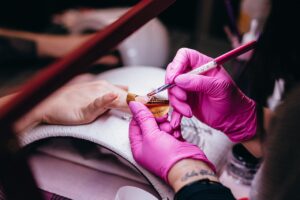Why Do Nails Keep Lifting? Acrylic, Gel, & Onycholysis
Nail lifting is a common concern among those who enjoy manicures, especially when using acrylic or gel products. Understanding the reasons behind this phenomenon can help you maintain healthy nails and prevent future issues. In this article, we will explore nail lifting, its causes, and the differences between acrylic and gel nails to empower you in your nail care journey.
Understanding Nail Lifting
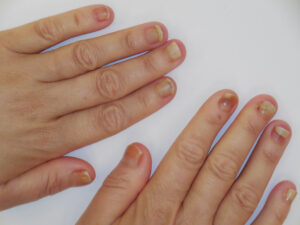
“Hands taxotere 1” by Anthere is licensed under CC BY-SA 3.0
Nail lifting occurs when the nail plate separates from the nail bed, leading to an unsightly appearance and potential discomfort. This separation can affect both acrylic and gel nails, as well as natural nails. By comprehending nail lifting, you can better appreciate how to maintain healthy nails and prevent lifting from becoming a recurring issue.
What is Nail Lifting?
Nail lifting refers to the condition where the affected nail becomes elevated and detaches from the nail bed. This can happen due to various factors, including improper nail prep or the use of low-quality nail products. When nails lift, they can become prone to infections or further damage, making it essential to understand the underlying causes to help prevent it from happening.
Common Causes of Nails Lifting
Several factors can lead to nails lifting, including inadequate adhesion between the nail product and the natural nail, improper nail preparation, and fungal infections. The cuticle area must be properly treated to ensure a strong bond between the acrylic or gel and the nail surface. Additionally, exposure to harsh chemicals, like nail polish remover, can weaken the bond, causing nails to lift and separate from the nail bed.
Differences Between Acrylic and Gel Nails
Acrylic and gel nails both provide beautiful enhancements to the natural nail but differ in their application and durability. Acrylic nails are created using a combination of acrylic powders and liquids, while gel nails rely on a gel formula that is cured under UV light. Understanding these differences can help you choose the right option for your manicure needs and minimize the risk of nail lifting, ensuring a long-lasting and attractive nail appearance.
The Role of Onycholysis
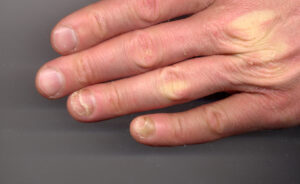
“Onycholysis left hand 34yo male ring and little fingers non-fungal” by CopperKettle is licensed under CC BY-SA 3.0
Defining Onycholysis
Onycholysis is a condition characterized by the separation of the nail plate from the nail bed, which can occur for various reasons, including trauma or fungal infections. When understanding onycholysis, it’s crucial to recognize its impact on nail health and appearance. This condition not only causes discomfort but also makes the affected nails prone to further complications, such as infections.
Symptoms and Signs of Onycholysis
The symptoms of onycholysis can be quite noticeable. You may observe a lifted nail plate that appears discolored or has a white, yellow, or green hue underneath. This discoloration often indicates the presence of a fungal infection. Additionally, you might experience discomfort or sensitivity in the affected nail. Recognizing these signs early is essential to prevent further damage and ensure prompt intervention to restore nail health.
Preventing Onycholysis in Acrylic and Gel Nails
To prevent onycholysis when using acrylic or gel nails, proper nail preparation and application techniques are essential. Ensuring that the cuticle area is adequately cleaned and that the nail surface is buffed can enhance adhesion between the product and the natural nail. It’s also vital to use high-quality nail products and avoid excessive exposure to nail polish remover.
Factors Leading to Nails from Lifting
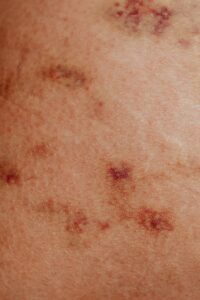
Photo by Photo By: Kaboompics.com on Pexels
Environmental Influences
Environmental factors can significantly contribute to nails lifting. Exposure to moisture, chemicals, or extreme temperatures can weaken the bond between the nail plate and the nail bed. Understanding these influences helps you take proactive steps in your nail care routine to minimize the risk of nail lifting.
Improper Application Techniques
Improper application techniques can also be a primary cause of nails lifting. If a nail technician fails to properly prep the nail surface or uses substandard products, the chance of lifting increases. This includes adequate curing times for gel manicures and ensuring a strong bond between the acrylic powders and the natural nail.
Health Conditions Affecting Nail Integrity
Various health conditions can affect nail integrity and contribute to nails lifting. Issues such as psoriasis, thyroid problems, or nutritional deficiencies can impact nail growth and strength. If you suspect an underlying health issue, consulting a healthcare professional is crucial.
Preventing Nails from Lifting
Best Practices for Acrylic Nails
To prevent acrylic nails from lifting, proper nail prep is essential. Start by ensuring the nail surface is clean and buffed, allowing for optimal adhesion. Regular maintenance and touch-ups can also keep your acrylic nails looking fresh and intact.
Maintaining Gel Nails
Maintaining gel nails requires diligence to prevent them from lifting. Ensuring that the nail surface is properly prepped and thoroughly cured under the UV light is crucial for achieving a strong bond. Incorporating a routine that focuses on keeping your nails hydrated and free of excess chemicals will enhance their durability.
Importance of Cuticle Care
Caring for the cuticle area plays a pivotal role in preventing nail lifting. Healthy cuticles contribute to the overall adhesion of nail products. Incorporating a cuticle oil into your nail care routine is an effective way to keep the cuticle area nourished and strong.
When to Seek Professional Help
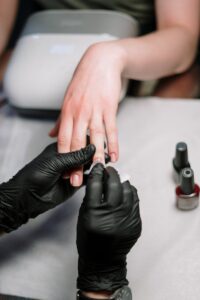
Photo by cottonbro studio on Pexels
Identifying Severe Cases of Nail Lifting
Recognizing when nail lifting has escalated to a severe case is critical for maintaining nail health. If you notice that the nail plate has significantly lifted from the nail bed and shows signs of discoloration or sensitivity, it may indicate a more serious underlying issue.
Professional Treatments for Onycholysis
When dealing with onycholysis, seeking professional treatments is essential for restoring nail health. A qualified nail technician or dermatologist can assess the affected nail and recommend appropriate interventions.
Consulting a Dermatologist vs. a Nail Technician
Choosing between a dermatologist and a nail technician can depend on the severity of your nail issues. If you are experiencing persistent or painful nail lifting, consulting a dermatologist is advisable. On the other hand, a nail technician specializes in nail care and can provide treatments that address cosmetic concerns.

